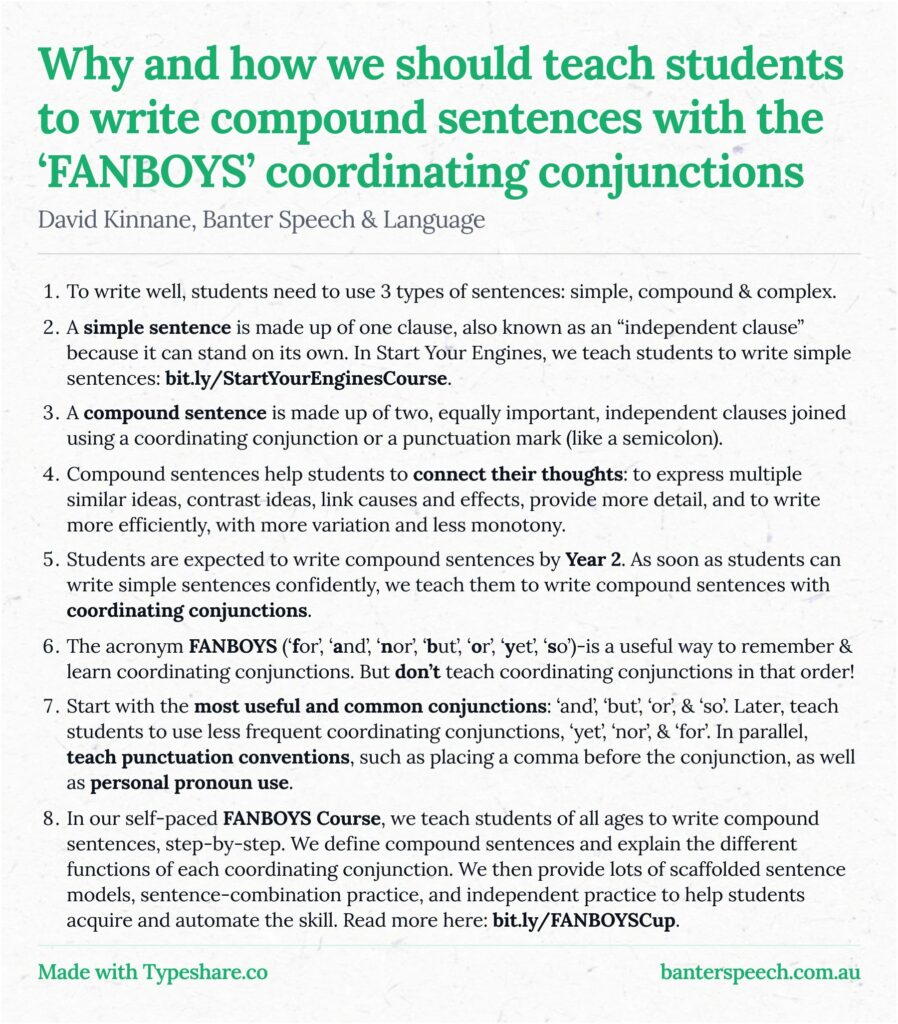Why and how we should teach students to write compound sentences with the ‘FANBOYS’ coordinating conjunctions
To write well, students need to use three types of sentences: simple, compound, and complex.
A simple sentence is made up of one clause, also known as an “independent clause” because it can stand on its own. In Start Your Engines, we teach students to write simple sentences.
A compound sentence is made up of two, equally important, independent clauses joined using a coordinating conjunction or a punctuation mark (like a semicolon).
Compound sentences help students to connect their thoughts: to express multiple similar ideas, contrast ideas, link causes and effects, provide more detail, and to write more efficiently, with more variation and less monotony.
Students are expected to write compound sentences by Year 2. As soon as students can write simple sentences confidently, we teach them to write compound sentences with coordinating conjunctions.
The acronym FANBOYS (‘for’, ‘and’, ‘nor’, ‘but’, ‘or’, ‘yet’, & ‘so’) – is a useful way to learn and remember coordinating conjunctions. But don’t teach coordinating conjunctions in that order!
Start with the most useful and common conjunctions: ‘and’, ‘but’, ‘or’, & ‘so’. Later, teach students to use less frequent coordinating conjunctions, ‘yet’, ‘nor’, & ‘for’. In parallel, teach punctuation conventions, such as placing a comma before the conjunction, as well as personal pronoun use.
In our self-paced FANBOYS Course, we teach students of all ages to write compound sentences, step-by-step. We define compound sentences and explain the different functions of each coordinating conjunction. We then provide lots of scaffolded sentence models, sentence-combination practice, and independent practice to help students acquire and automate the skill.
Read more: The FANBOYS Cup: How to Write Compound Sentences.

Related reading:
Is your child or teenager a Reluctant Writer?
Don’t skimp on complex sentence work when teaching students to listen, speak, read, and write
How to create a daily writing habit with a dedicated nook
11 ways to improve writing interventions for struggling students
Research links:
Lingard, L. (2017). Mastering the sentence | Perspectives on Medical Education
AERO Practice guide – Compound Sentences
This article also appears in a recent issue of Banter Booster, our weekly round up of the best speech pathology ideas and practice tips for busy speech pathologists, speech pathology students and others.
Sign up to receive Banter Booster in your inbox each week:

Hi there, I’m David Kinnane.
Principal Speech Pathologist, Banter Speech & Language
Our talented team of certified practising speech pathologists provide unhurried, personalised and evidence-based speech pathology care to children and adults in the Inner West of Sydney and beyond, both in our clinic and via telehealth.








